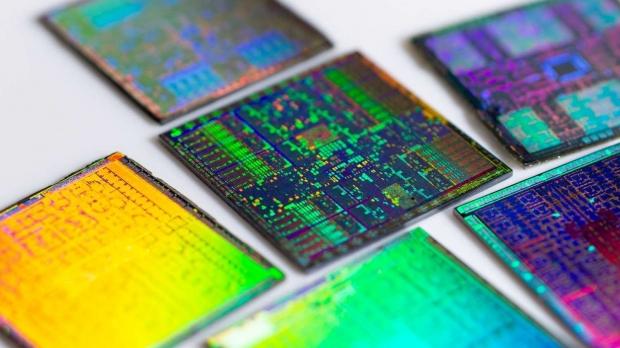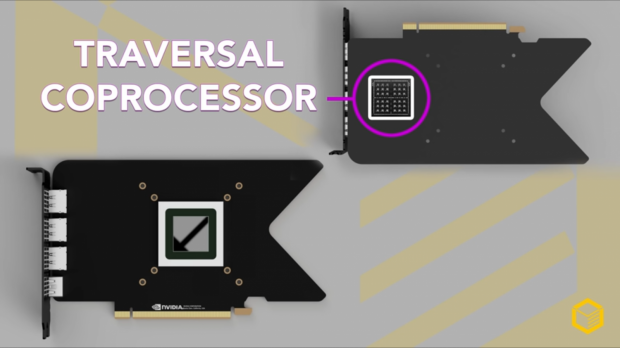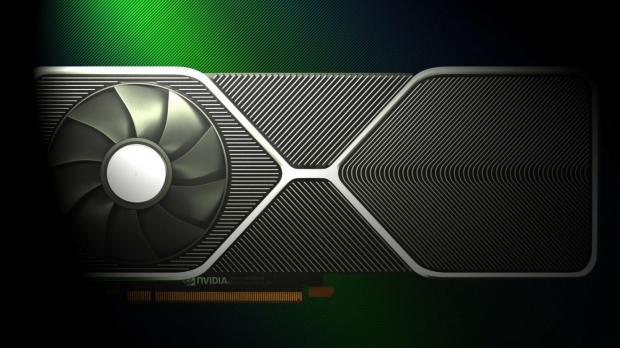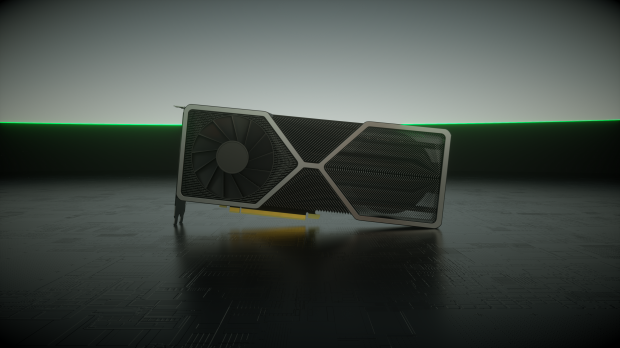NVIDIA announced the "Ultimate Countdown" towards its next-gen Ampere GeForce graphics cards, but then there were the hints using numbers and more specifically: 21.

After posting the #UltimateCountdown tweet, NVIDIA added: "21 Days. 21 Years" which signifies August 31 (21 days after the countdown was announced on August 10) and it has been 21 years since the first GeForce, the first-ever GPU, the GeForce 256.
So much around the number 21 that if you take '256' and times it by '21' you get 5376, which is the purported number of CUDA cores on NVIDIA's upcoming GA102 GPU.
My friend Usman Pirzada over at Wccftech tweeted "256 * 21 = 5376" but then the second I saw that, it clicked -- so I tweeted: "5376 = 5 + 3 + 7 + 6 = 21". NVIDIA could be f***ing with us, but it seems they're pointing towards 21 for some reason.
So let's think about that -- 21 is significant in many ways.
- 21 days until next-gen GeForce reveal.
- 21 years since the first ever GPU.
- 21 years since the first GeForce graphics card.
- The first GeForce graphics card was the GeForce 256.
- GeForce 256 was offered in 2 different VRAM options: SDR and DDR.
- The '256' times '21' = 5376 and then 5+3+7+6 = 21.
- AMD has Navi 21 coming.
- Navi 21 will compete with Ampere.
21 seems very important to NVIDIA.
So all of those connections into '21' above, what about the most important of them all: the nomenclature of the next-gen GeForce graphics card.
What if NVIDIA is trolling all of us with '21' and throwing us off track, given that 21 seems to work for so many layers of this -- and the actual reveal is GeForce RTX 21 series. I mean, it's logical considering the leap from GeForce GTX 10 series to the GeForce RTX 20 series.
It's a similar move Samsung did with the Galaxy S10 to the Galaxy S20 -- it wasn't the Galaxy S10 to Galaxy S11, but rather the Galaxy S20 which kicked off the year 2020, and then the rumored Galaxy S21 is slated for next year. What if NVIDIA is shifting into the GeForce RTX 21 series for 2021 and beyond, as well as the next number after GeForce RTX 20 series.
Another connection is that Samsung and NVIDIA are working together on 8nm GPUs for the first flock of Ampere GPUs on the next-gen GeForce RTX series (no matter what nomenclature it launches with). Maybe NVIDIA took some inspiration from Samsung with their naming scheme going forward.
What do you prefer? Now these models are not confirmed, but I think we could see an "ULTIMATE" branded card, maybe a new "TITAN RTX ULTIMATE" or something along those lines. I would personally love to see the return of the ULTRA branding, but that's just me being a nerd.
- GeForce RTX 2190 ULTIMATE
- GeForce RTX 2190 ULTRA
- GeForce RTX 2190
- GeForce RTX 2180 Ti
- GeForce RTX 2180
- GeForce RTX 2170
- (and so on)
Or...
- GeForce RTX 3090 ULTIMATE
- GeForce RTX 3090 ULTRA
- GeForce RTX 3090
- GeForce RTX 3080 Ti
- GeForce RTX 3080
- GeForce RTX 3070
- (and so on)
It seems like NVIDIA has pushed almost all-in with the number 21, so maybe I'm wrong -- but I'm going to put this out there for the world to ingest. Fire away in the comments on social media, you can hit me up personally on Twitter if you want to discuss the GeForce RTX 21 series.

- NVIDIA and TSMC troubles over 7nm: NVIDIA shifted some of its foundry weight to Samsung in 2019, but AMD quickly started seeing wins with its effiencicy on 7nm TSMC and went to move back for Ampere. But AMD had secured the gigantic chunk of 7nm TSMC fab time with its various chips. This forced NVIDIA to split between Samsung (RTX 3080 and others) and then TSMC (higher-end RTX 3090, etc).
- AMD gobbling up all that 7nm: AMD is gobbling up all that 7nm production at TSMC, between its Ryzen, Threadripper, and EPYC processors -- then its Radeon RX series graphics cards (both current, and RDNA 2-based next-gen cards) as well as the PlayStation 5 and Xbox Series X chips are all on 7nm over at TSMC.
- GeForce RTX 3080 = 8nm with Samsung: This wasn't meant to happen, but it is -- and NVIDIA has no option but to deal with it. NVIDIA will use Samsung's new 8nm node for at least 3 of its Ampere GPUs (you can read more on that here), but they won't quite have the power to completely topple Big Navi.
- GeForce RTX 3090 = 7nm with TSMC: However, the higher-end GeForce RTX 3090 will -- but it'll launch in Q1 2021. This card, is what is being called inside NVIDIA as the trump card.
- NVIDIA's trump card: GeForce RTX 3090 will be made on 7nm with TSMC, and this should be quite the monster indeed with it rumored to be 45-60% faster than the RTX 2080 Ti. This will be the card that NVIDIA strikes down very, very hard in early 2021.
More reading:

- Traversal coprocessor: We have had more leaks on NVIDIA's next-gen GeForce RTX 3000 series than any family of graphics cards before it, with an interesting "traversal coprocessor" on the new GeForce RTX 3080 and GeForce RTX 3090 graphics cards. You can read more on that here.
- NVCache: Ampere is meant to have something called NVCache, which would be NVIDIA's own form of AMD's HBCC (High Bandwidth Cache Controller, more on that here). NVCache would use your system RAM and SSD to super-speed game load times, as well as optimizing VRAM usage. You can read more on NVCache here.
- Tensor Memory Compression: NVCache is interesting, but Tensor Memory Compression will be on Ampere, and will reportedly use Tensor Cores to both compress and decompress items that are stored in VRAM. This could see a 20-40% reduction in VRAM usage, or more VRAM usage with higher textures in next-gen games and Tensor Memory Compression decreasing that VRAM footprint by 20-40%.
- How fast is the GeForce RTX 3090? Freaking fast according to rumors, with 60-90% more performance than the current Turing-based flagship GeForce RTX 2080 Ti. We could see this huge performance leap in ray tracing titles, but we'll have to wait a little while longer to see how much graphical power NVIDIA crams into these new cards. You can read more on those rumors here.
- Power hungry: As for power consumption, GA102 reportedly uses 230W -- while 24GB of GDDR6X (which we should see on the new Ampere-based TITAN RTX) consumes 60W of power. You can read more on that here.
- Production begins soon: NVIDIA is reportedly in the DVT (or Design Validation Test) range of its new GeForce RTX 3000 series graphics cards. Mass production reportedly kicks off in August 2020, with a media event, benchmarks, and more in September 2020 as I predicted many months ago. More on that here.

I've already written about rumors that NVIDIA's next-gen Ampere GPU architecture would be up to 75% faster than current-gen GPUs such as the Turing architecture, right after rumors that Ampere would offer 50% more performance at half the power of Turing. This is pretty crazy stuff right there.
Not only that, but we've got some rumored specs on the purported GeForce RTX 3080 and GeForce RTX 3070 graphics cards, which will both be powered by NVIDIA's new Ampere GPU architecture.
We've already heard that Ampere would offer 50% more performance at half the power of Turing, which sent the hairs on my neck standing up. Better yet, you can read about the leaked specs on the purported Ampere-based GeForce RTX 3080 and GeForce RTX 3070 right here.

Even more reading:
- NVIDIA GeForce RTX 3000 series announcement rumored for September 9
- NVIDIA reportedly discontinues GeForce RTX 2070 SUPER graphics card
- NVIDIA GeForce RTX 3080 Ti: rumored launch of September 17
- AMD Big Navi: 5120 stream processors teased for RDNA 2 flagship again
- AMD Radeon Instinct MI100 Acturus teased, NVIDIA Ampere destroyer?!
- GeForce RTX 3090: 50% faster than RTX 2080 Ti in early benchmarks
- NVIDIA A100 Ampere benchmarked, is now the 'fastest GPU ever recorded'
- Yeah, NVIDIA should unleash GeForce RTX 3000 series in September
- AMD Big Navi 'NVIDIA Killer' flagship card has 16GB of memory
- NVIDIA GeForce RTX 3080 rumor: 20% faster than GeForce RTX 2080 Ti
- NVIDIA's next-gen Ampere DLSS 3.0 could work on ANY game that uses TAA
- AMD aims Big Navi launch for November as 'show of strength' for RDNA 2
- NVIDIA's next-gen Ampere GeForce RTX 30 series: new 12-pin PCIe power
- AMD's next-gen RDNA 2 rumor: 40-50% faster than GeForce RTX 2080 Ti
- NVIDIA stops making RTX 20 series, ramps to GeForce RTX 30 series
- GeForce RTX 3060 should cost $300-$400, here's some leaked specs
- NVIDIA bundles Death Stranding with GeForce RTX graphics cards
- NVIDIA GeForce RTX 3070 Ti, RTX 3070 rumored specs: two sub $500 cards
- Want NVIDIA's next-gen Ampere GPU now? You can have it... for $12,500
- NVIDIA's Ampere GeForce RTX rumor: built on Samsung 8nm, not TSMC 7nm
- Say hello to the ASUS GeForce RTX 3080 Ti ROG STRIX, maybe
- NVIDIA's new A100 PCIe accelerator: 40GB HBM2e memory, PCIe 4.0 tech
- This new GeForce RTX 3090 leak has it at 26% faster than RTX 2080 Ti
- New GeForce RTX 3090 leaks: 12GB GDDR6X at insane 21Gbps
- GeForce RTX 3080 and RTX 3090 rumored to pack 'traversal coprocessor'
- NVIDIA's next-gen GeForce RTX 3080, RTX 3090 to enter production soon
- GeForce RTX 3090: GA102 consumes 230W, 24GB GDDR6 consumes 60W power
- NVIDIA rumored to use HUGE cooling block on GeForce RTX 3080
- NVIDIA GeForce RTX 3080 cooler: rumored to cost $150 on its own
- GeForce RTX 3090 rumor: 24GB GDDR6X, would annihilate RTX 2080 Ti
- NVIDIA GeForce RTX 3090 rumors: up to 60-90% faster than RTX 2080 Ti
- Check out these awesome renders of NVIDIA's next-gen GeForce RTX 3080
- This could be our first picture of the GeForce RTX 3080 graphics card
- AMD and NVIDIA to both launch next-gen GPUs in September 2020
- NVIDIA reportedly drops Tesla brand, too close to Elon Musk's Tesla
- NVIDIA amps up fight against COVID-19 with Ampere-based supercomputer
- NVIDIA DGX A100: 8 x A100 Ampere GPUs, AMD CPU, 15TB NVMe SSD
- NVIDIA Ampere A100 specs: 54 billion transistors, 40GB HBM2, 7nm TSMC


